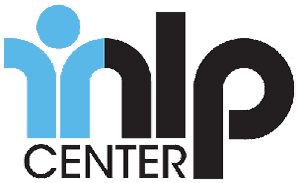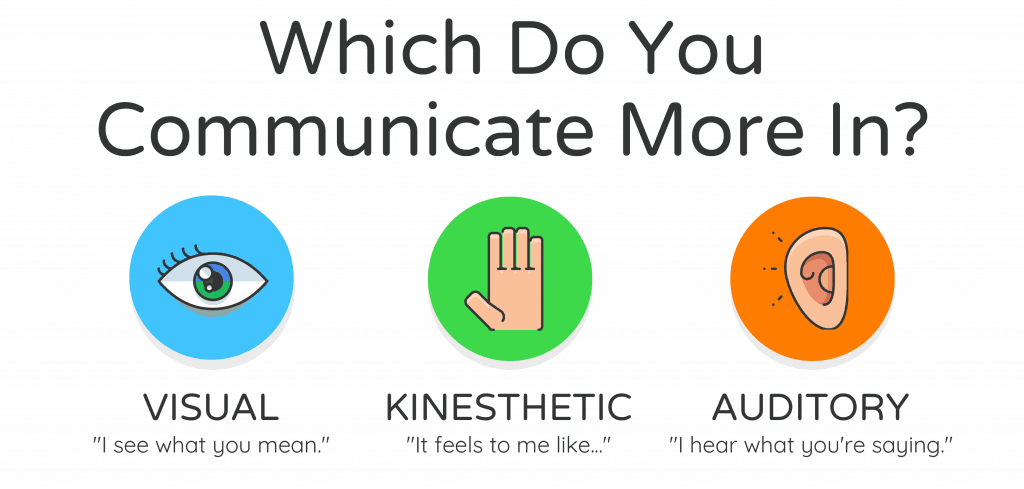NLP VAK modalities refer to the three ways the human brain processes information: Visual, Auditory, and Kinesthetic. Everyone uses all three when communicating but we tend to prefer one over the others.

In developed countries, studies show that:
- 60% of people process information in a visual way,
- 20% in an auditory way,
- and 20% kinesthetically
There are different characteristics that someone might have in each category, as well.
Note we’re not talking about submodalities, which are a different NLP concept (though related).
3 Types of Modalities: The VAK System
Auditory
Someone who is auditory is more rhythmic and does things in patterns. They’re usually good at repeating things back to you. They say things like, “We worked together in harmony,” which is an auditory phrase.
Auditory learners do best by listening and rely on hearing and speaking to process information. Unless the information is heard, it isn’t likely that an auditory learner will retain the information.
Visual
A person who thinks visually processes information quickly, uses descriptive language, and performs a lot of hand gestures. They’ll usually use phrases like, “It appears we have a sketchy situation.” Someone who learns visually is usually good at reading maps, and can easily understand something by just reading it. Often, they believe that “seeing is believing”.
Personally, I am a visual learner. I find myself having to write things down so that I can see them and understand them. I have also found that I have an easier time spelling when I’m writing something down, rather than spelling from memory. Seeing the word, and how it looks is what triggers the memory of how the word is spelled, and I believe that is because I am a visual learner.
Kinethetic
Kinesthetic people are much slower to process information. They take their time speaking and respond better to touch and physical rewards. Someone who is kinesthetic might say something like, “I have a problem weighing on me heavily,” indicating that they physically feel their problem.
Kinesthetic learners prefer to be “moving and doing” and are frequently called “do-ers” because they respond best to being active when learning. If you have ever had a classmate that could not sit still during class, and always had to be up doing something, that person was probably a kinesthetic learner.
How to Know Which Modality Someone Prefers
Upon learning this information, I took it upon myself to figure out which NLP VAK modalities people in my life prefer. I began by simply paying attention to the predicates that my fiancé uses when describing certain events or memories.
I noticed he often says things like “It boils down to this” or “He pulled some strings” – indicating that he was referencing a kinesthetic modality.
I continued my investigation of NLP VAK modalities.
I noticed that he takes his time to process information and responds better to touch and action than to words. To further my belief that he is a generally kinesthetic person, I took into account that he is a mechanic who prefers to learn by doing and usually teaches himself.
Each of us gives indicators to which form of processing we prefer. We do this with the words we choose to use. We can’t help it, because if that is the way that we are processing the information, then that is how we are also going to communicate.
Why NLP Modalities Matter
A huge part of NLP VAK modalities is knowing how you and others experience the world around you. It is normal to come across people that you don’t naturally connect with. Knowing how a person communicates or processes information can make things a bit easier, especially if this person is someone with whom you must communicate with on a regular basis, such as your boss or coworker.
Do you feel like there is someone in your life that you just can’t see eye to eye with? Like no matter what you do, you just can’t communicate or get through to this person? Or maybe there’s someone in your life who just understands you.
This is most likely because of your NLP VAK modalities. It has to do with how you and the other person process information.
NLP VAK modalities can shine some understanding of how “connecting” works.
Want to discover more NLP techniques and learn how to create rapid change in yourself and others? Here’s how to choose the right NLP certification program.

Further Reading
How to Stop Making Bad Choices using NLP’s VAK Technique
Love Languages of NLP – Using VAK to Increase Awareness
NLP Submodalities – Here’s a Revolutionary Way to Use Them in Coaching
- Mindfulness Training: Experience the Benefits in Your Life - 01/07/2020
- NLP Modalities: Visual, Auditory & Kinesthetic (VAK) - 02/11/2016
- What NLP Accessing States Has Taught Me - 02/11/2016


